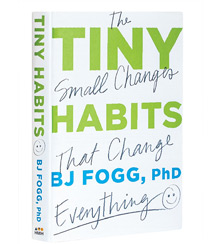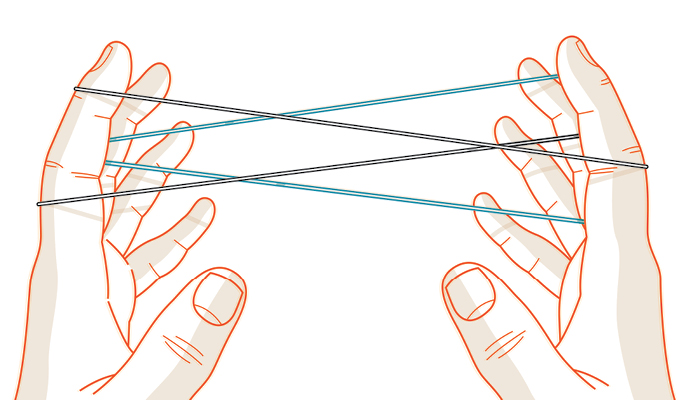Best Business Books 2020: Management
Managing in a pandemic year
B.J. Fogg
Tiny Habits: The Small Changes That Change Everything (Houghton Mifflin Harcourt, 2020)
*A TOP SHELF PICK
Deborah Gruenfeld
Acting with Power: Why We Are More Powerful Than We Believe (Currency, 2020)
Kate Murphy
You’re Not Listening: What You’re Missing and Why It Matters (Celadon Books, 2020)
This year, COVID-19 upended management-as-usual. Sure, managing is still a matter of getting things done in organizations — divvying up objectives into tasks, ensuring employees have the resources and skills to complete the tasks, overseeing their progress, and helping them when they get bogged down. But where and how people work has changed — radically and overnight in many companies and, in some, maybe permanently.
These developments have given rise to new needs and stresses that affect the people you are responsible for managing — needs such as going to work (or going back to work) safely, and stresses such as working while surrounded by kids instead of colleagues — and thus, they’ve also affected your performance as a manager.
None of this year’s best business books on management were written for managers per se. But each focuses on capabilities that can help managers identify and cope with pandemic-related challenges.
In the year’s best business book on management, Tiny Habits, Stanford University researcher B.J. Fogg shows how to change your behavior and help others change theirs, too — an essential skill at a time when we are all being called upon to develop new habits. In Acting with Power, Deborah Gruenfeld, also at Stanford, explains how an unconventional view of power can enable you to support people in ways that far exceed the limits of your positional authority. And in You’re Not Listening, journalist Kate Murphy offers an uncommonly insightful exploration of how to actually meet the dictates of an exhortation we’ve all heard before: “Listen!”
A lesson from Instagram
Back in the mid-1990s, B.J. Fogg coined the term captology to describe the persuasive power of computers and then taught his students at Stanford how to use that power. One of them was Mike Krieger, who, with Kevin Systrom, used Fogg’s insights to remake a failed project into a simple photo-sharing app. They launched Instagram on the iPhone App Store in 2010 and, less than two years later, sold it to Facebook for a breathtaking US$1 billion in cash and stock. As it turned out, Facebook CEO Mark Zuckerberg got it cheap — in 2018, Bloomberg estimated Instagram’s value at $100 billion.
But Fogg was playing a bigger game. He didn’t care as much about computers as he did about people — in fact, he was warning us about the ethical pitfalls of digital persuasion early on. In his work, he was trying to figure out how to make behavior change as easy as using Instagram (or whichever app steals an inordinate amount of your time these days). Fogg reveals what he discovered in his new self-help book, Tiny Habits: The Small Changes That Change Everything — written with all the infomercial-like brightness the genre implies — and it could have a transformative effect on your managerial performance.
Tiny Habits is a self-help book — written with all the infomercial-like brightness the genre implies — that could have a transformative effect on your managerial performance.
Underlying Fogg’s pitch is a model with three variables: B = MAP. “A behavior happens,” he explains, “when the three elements of MAP — Motivation, Ability, and Prompt — come together at the same moment.” Motivation is the desire to exhibit the behavior. Ability is the capacity to exhibit it. Prompt is the cue to exhibit it. According to the equation, if you want to craft a positive behavior or troubleshoot a negative one in others, you need to analyze the three elements, but in reverse order.
Don’t start with motivational responses such as imposing a penalty or giving tardy attendees dirty looks, says Fogg. Instead, confirm there are prompts in place that encourage people to get to the meeting on time. Then, make sure the tardy attendees are able to get to the meeting on time. Turn to motivation only if the first two elements aren’t causing the desired behavior. “In many cases, you’ll find your lack of doing a behavior is not a motivation issue at all,” he explains. “You can solve a behavior by finding a good prompt or by making the behavior easier to do.”
This low-key approach to behavior change typifies the advice in Tiny Habits. Fogg argues that we make change hard on ourselves and others by hewing to admonitions like “go big or go home.” When the effort fails, we blame ourselves or others. (I’m thinking about every New Year’s resolution, ever.) Instead, stop judging. Break your aspirations into tiny behaviors. Embrace mistakes as discoveries, and use them to move ahead. “Tiny is mighty. At least when it comes to change,” Fogg declares in the first two sentences of the book.
The Tiny Habits methodology is a three-step process that harks back to Fogg’s behavior model. First, choose an anchor moment — an existing routine or event in your day that prompts the new thing you want to do. In trying this method for myself, I discovered that you must have a solid, regular prompt — like pouring your morning cup of coffee — or you’ll forget to do whatever it is you want to do.
Second, attach a tiny behavior to it. When Fogg wanted to make flossing his teeth an ingrained behavior, he started with one tooth. When Sarika, a project manager in a Fortune 500 company, wanted to start getting healthier by making herself breakfast every morning, her tiny behavior was turning on the stove — that’s it, just turning it on.
Third, take a moment to celebrate as soon as you complete the new behavior. Why celebrate turning on the stove? “Emotions create habits. Not repetition. Not frequency. Not fairy dust. Emotions,” writes Fogg.
A tiny habit — like flossing one tooth — may seem inconsequential. But Fogg maintains that it’s the only consistent, sustainable way to undertake big changes. “One tiny action, one small bite, might feel insignificant at first, but it allows you to gain the momentum you need to ramp up to bigger challenges and faster progress,” he writes.
Fogg’s work stands apart from the self-help author crowd, which frequently devolves into infomercial sloganeering. He founded Stanford’s Behavior Design Lab and he has taught behavioral change to more than 40,000 people. And the methodology described in Tiny Habits is a tool that any manager can use to improve performance — his or her own, or that of a team — which is why it’s my pick for the year’s best business book on management.
Power plays
Speaking of tiny habits, Deborah Gruenfeld, a social psychologist and the Joseph McDonald Professor at the Stanford Graduate School of Business, describes one about three-quarters of the way through her book, Acting with Power: Why We Are More Powerful Than We Believe. After realizing that she was routinely obsessing about negative student reactions and that the habit was coloring her attitude toward teaching, Gruenfeld began spending a few minutes before each class thinking about positive student reactions.
“It was a turning point in my life as an educator,” she explains. “It may not always come naturally, even to this day, but it is foolproof, and it is not hard to do.” For Gruenfeld, this is not so much a tiny habit as it is an example of choosing love over fear — a technique that actors (and managers) can use to “show warmth and caring in a powerful role.”
Many managers are uncomfortable with power. Perhaps it is because they occupy a middle ground in which they have power over employees and yet are still subordinate to the power of executives. Acting with Power offers a means of reframing how we understand power and tapping into a wellspring of influence that is available to all of us.
If you’re a manager, though, Gruenfeld’s view of power, which she has been teaching to Stanford MBA students and executives for more than a decade, should have particular resonance. “Power is a part you play in someone else’s story,” she writes. “What makes someone powerful — what makes others willing to comply with their wishes — is the degree to which they are needed…. Power lives and dies in relationships, in goals and objectives, in settings, and in social roles.”
This idea of power as a role that you can assume, as an actor would a part, is particularly freeing (as well as a refreshing alternative to the current authenticity fad). It enables you to follow Dame Judi Dench’s wonderful advice, “The trick is to take the work seriously, but not take yourself seriously at all,” and avoid the dysfunctions that afflict power-hungry and power-mad people. And it allows you to free yourself from the constraints of positional power and make full use of what Gruenfeld calls “the two faces of power.”
“Power has two faces, no matter who you are,” she explains. “You can play it up, show it off, and remind others who has the upper hand. And you can play it down, minimize it, and remind others how important they are…. To use power well, you will want to get comfortable showing both [faces].”
Pulling rank, poking fun, interrupting, and saying no are all ways of playing power up. It sounds hostile, but, says Gruenfeld, “the thing to keep in mind is that in many group situations, playing power up is the most generous thing you can do.” Groups need managers to play power up when they lack direction or when situations become chaotic.
Backing off, using self-deprecating humor, and asking for help are all ways of playing power down. Playing down can be seen as a way to appease others or shirk responsibility, but Gruenfeld explains, “it can also be a way of showing respect, building trust, and making others feel safe.”
It is Gruenfeld’s application of these ideas that transforms Acting with Power from an intriguing read to a best business book for managers. No matter which way you are playing power, like any actor, you need to embrace the role. Gruenfeld offers several techniques for doing so and explains that the core challenge revolves around integrity: “Acting with power is striving for integrity by doing whatever it takes to get into a mindset that makes it possible to do the responsible thing.” She also explains how to be more effective in a supporting role (one that managers are always called upon to play), how to overcome performance anxiety, and how to stop power abusers, including bullies, megalomaniacs, and sexual harassers.
If you feel like you are hamstrung in the effort to cope with the disruptions in this pandemic year, Acting with Power will help you stretch your muscles.
Listen up
Remember when Mark Zuckerberg walked off to look for America? In 2017, he spent a year traveling the country to “talk to more people about how they’re living, working, and thinking about the future.” He brought along an entourage, including a photographer who took pictures of him listening.
“What Zuckerberg got right was listening is a challenge,” writes Kate Murphy, a journalist who contributes frequently to the New York Times, and the author of You’re Not Listening: What You’re Missing and Why It Matters. “What he got wrong — and [what] made him the object of considerable mockery online and in the press — was thinking contrived listening was the same as actual listening.”
You’re Not Listening is a postgraduate course in an art and a craft that is essential to good management and yet woefully scarce. “Listening is the neglected stepchild of communication research, pushed aside by investigation into effective elocution, rhetoric, argumentation, persuasion, and propaganda,” reports Murphy. “Browse the three-volume, 2,048-page International Encyclopedia of Interpersonal Communication and you’ll only find one entry specific to listening. And you won’t even find listening in the index of The Sage Handbook of Interpersonal Communication.”
Murphy does a fine job of remedying this oversight in an engaging, Malcolm Gladwell–esque approach that’s got a broad scope. One topic she lights on is the shortcomings of big data and analytics, which have replaced more expensive qualitative research, such as focus groups, in marketing. The problem is that a survey or analysis of social media data isn’t going to yield the granular insights that lead to products like the Swiffer. The germ of that idea arrived when a woman in a focus group composed of “super-cleaners” explained that she saved lightly used paper towels and reused them to wipe the floor with her foot at the end of the day. Procter & Gamble listened — and built a half-billion-dollar brand.
In passages more pertinent to the needs of managers, Murphy provides practical and nuanced advice for becoming a better listener. For instance, she explains the difference between shift and support responses (first described by sociologist Charles Derber) — and why the latter are so important to good listeners. Shift responses direct attention away from the speaker and toward the listener; support responses encourage the speaker to elaborate.
Effective support responses, Murphy says, seek “to understand the speaker’s point of view, not to sway it.” Open-ended and fill-in-the-blank questions work well in this regard, as long as they are truly curious and don’t contain hidden assumptions or attempts to subvert the conversation. “Good questions don’t begin with: ‘Don’t you think…?’ ‘Isn’t it true…?’ ‘Wouldn’t you agree…?’ And good questions definitely don’t end with ‘right?’” she explains.
Where you listen is as important as how you listen. A secluded, soundproof space will seldom be available, but, says Murphy, “you can wave someone into your office and put your computer to sleep. You can choose quiet restaurants and silence your phone and keep it out of sight. You can find a park bench, take a walk on a quiet street, or just duck into a doorway away from the stream of pedestrians to have a word.” Consciously choosing a setting sends a signal about your willingness to listen.
I found Murphy’s advice on silences particularly apropos, because I’m always too quick to fill them. “As a journalist, it took me too long to realize that I didn’t have to say anything to keep the conversation going,” she writes. “Some of the most interesting and valuable bits of information have come not from my questioning but from keeping my mouth shut.”
And with that in mind, I’ll shut mine and give You’re Not Listening the final word: “When you engage with someone, your behavior does two things: (1) it helps or hinders your understanding, and (2) [it] strengthens or weakens the relationship. Listening is your best bet on both counts.”
Author profile:
- Theodore Kinni is a contributing editor of strategy+business. He blogs at Reading, Writing re: Management and is @tedkinni on Twitter.








